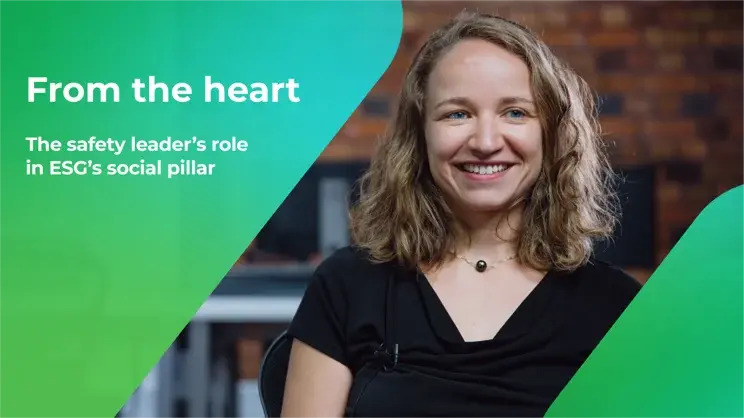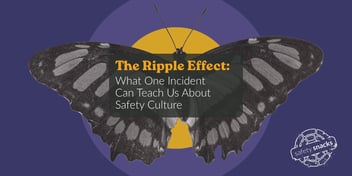Changing workforce dynamics as well as increased pressure from internal and external stakeholders are forcing organisations to focus on the social pillar of ESG (Environmental, Social and Governance) as an organisational success metric more than ever before.
With the social aspects of ESG foregrounding a business’s impact on its employees, its customers, and the community, it’s clear that safety leaders are uniquely placed to address social factors within their organisations. And yet, their exact role in building fair and trustworthy environments for all stakeholders remains ill-defined.
In this article, I offer my insights on how the health and safety function can work towards and complement ESG efforts, and discuss how leading from the heart can be a catalyst for real change that creates stronger and more successful organisations built around happy, healthy communities.
What’s behind the rise of the Social pillar of ESG
Today’s consumer demands immense social change and a more equitable world, influencing a greater emphasis on the social justice concerns underpinning ESG’s social pillar.
Workers in numerous sectors world-wide have also seen their bargaining power increase during the pandemic, due to depleted workforces and a rise in flexible working structures, causing a further push towards human-centred workplaces and systems.
Despite its impact on almost every aspect of an organisation, however, the social pillar remains a frequently underdeveloped element of ESG strategy. Standardised metrics to record nuanced social progress outside of physical safety are far less abundant than in the environmental and governance aspects, and for many, real social change—especially rectifying historical equity and labour injustices—can be difficult to envision, though such change is urgent.
Many individuals don’t want to change because they’re used to another way, even if that other way is harder and unjust. Company cultures centred around tradition and rigid hierarchies can further slow progress.
Sometimes, big change only comes about when the consumer or worker demands it—when social values shift, placing reputations on the line. However, small steps can and should be taken far before that point.
Get fresh H&S insights weekly
Changing workforce dynamics as well as increased pressure from internal and external stakeholders are forcing organisations to focus on the social pillar of ESG (Environmental, Social and Governance) as an organisational success metric more than ever before.
With the social aspects of ESG foregrounding a business’s impact on its employees, its customers, and the community, it’s clear that safety leaders are uniquely placed to address social factors within their organisations. And yet, their exact role in building fair and trustworthy environments for all stakeholders remains ill-defined.
What’s behind the rise of the Social pillar of ESG
In this article, I offer my insights on how the health and safety function can work towards and complement ESG efforts, and discuss how leading from the heart can be a catalyst for real change that creates stronger and more successful organisations built around happy, healthy communities.
Today’s consumer demands immense social change and a more equitable world, influencing a greater emphasis on the social justice concerns underpinning ESG’s social pillar.
Workers in numerous sectors world-wide have also seen their bargaining power increase during the pandemic, due to depleted workforces and a rise in flexible working structures, causing a further push towards human-centred workplaces and systems.
Despite its impact on almost every aspect of an organisation, however, the social pillar remains a frequently underdeveloped element of ESG strategy. Standardised metrics to record nuanced social progress outside of physical safety are far less abundant than in the environmental and governance aspects, and for many, real social change—especially rectifying historical equity and labour injustices—can be difficult to envision, though such change is urgent.
Many individuals don’t want to change because they’re used to another way, even if that other way is harder and unjust. Company cultures centred around tradition and rigid hierarchies can further slow progress.
Sometimes, big change only comes about when the consumer or worker demands it—when social values shift, placing reputations on the line. However, small steps can and should be taken far before that point.The greatest opportunity for EHS leaders to effect change lies within the social pillar as the home-base of the two systems’ crossover.
Health and Safety leaders push for organisational change that increases everyone’s ability to go home whole and happy at the end of each day. Thorough reporting on this process’ pain points and successes produces metrics that support the evaluation of the business’ impact on the community. ESG then contextualises this data, and reflects on the company’s ability to grow through investment.
Of course, EHS leaders need to make sure their teams and processes are compliant; but they also need to communicate the importance of how everything fits together to their leaders and communities. As recently as a decade ago, this communication mostly happened through posters.
We now know that hanging up lots of posters doesn’t teach people much. The safety leader doesn’t have to be creative, but can engage with other people who are—change managers, facilitators. Those people have the tools to support building a culture where people can be open and honest.
.
Health and Safety within ESG
An organisation’s approach to EHS bears deep relevance across all three ESG pillars, with the outcomes of ESG having a massive impact on the health and safety of its employees, market, and community and vice versa.
For example, if an organisation destroys wetlands and floodplains for the sake of urban development, the vital flood mitigation these areas provide is lost, increasing the risk of flooding, an environmental disaster. This outcome’s social impacts are dire, as flooding would displace communities and damage infrastructure. Complying with comprehensive risk management governance and ensuring the necessary rules and regulations are in place can prevent these catastrophic outcomes.
In numerous other instances, ESG and EHS remain entwined in theory and practice, and health and safety leaders can support the foundations of ESG goal-setting by identifying the challenges at the root of the system from their perspective.
The role of safety leaders in addressing social factors
The greatest opportunity for EHS leaders to effect change lies within the social pillar as the home-base of the two systems’ crossover.
Health and Safety leaders push for organisational change that increases everyone’s ability to go home whole and happy at the end of each day. Thorough reporting on this process’ pain points and successes produces metrics that support the evaluation of the business’ impact on the community. ESG then contextualises this data, and reflects on the company’s ability to grow through investment.
Of course, EHS leaders need to make sure their teams and processes are compliant; but they also need to communicate the importance of how everything fits together to their leaders and communities. As recently as a decade ago, this communication mostly happened through posters.
We now know that hanging up lots of posters doesn’t teach people much. The safety leader doesn’t have to be creative, but can engage with other people who are—change managers, facilitators. Those people have the tools to support building a culture where people can be open and honest.
1. Opening a dialogue
Giving everyone access to the health and safety system is vital to letting them know it is being taken seriously, and for everyone to be able to participate in constructing an accurate picture. These and other channels should be offered as platforms for employees to share openly, honestly, and—if necessary—confidentially about occurrences and what does or doesn’t work for them.
Safety leaders need to be role models of listening and care in order to facilitate real change. More often than not, a company is not seeking to cause undue stress on its staff, but without a culture in which people feel comfortable speaking up if something doesn’t work for them, it becomes much less likely that they will feel free to suggest an alternative.
Before rejecting a request, it’s always worth asking, is this actually non-viable, or am I reluctant to shift a comfortable-for-me status quo towards a future that fits more people better? Even if a request must be denied, it’s important to explain why. Ideally, this will lead to conversation that discovers compromise. Big change is not always immediately feasible financially or logistically, but it always pays to ask what small steps can be taken now and later.
2. Facilitating communication with stakeholders
EHS reports can often end up technical and dry, the data failing to resonate with the board. The most important role of the EHS manager is as storyteller—connecting organisational and operational data, and creating a compelling narrative of actions, strategies, and targets that help the board make its decision.
Historically, health and safety reports and measures have often revolved around avoiding fines or prison. This is important, but can prioritise avoiding the ‘bad’ over building the ‘good’. The social pillar is an opportunity to stop centring metrics like LTIFR and start quality discussion on how to add value.
After working with a range of employees to build the full picture, the EHS leader can knowledgeably communicate to the board the social aspects on employees’ minds and what is being or might be achieved beyond baseline numbers. Though reporting social factors is notoriously difficult, a little time to build a balanced, contextualised picture goes a long way.
3. Making the business case
Numerous studies confirm that when a team feels validated, welcome, and respected in the work environment, the company is stronger financially and has fewer accidents. Such measures also lead to a stronger external reputation with clients and job candidates, and good press.
When people feel welcome in their workplace, they’re less likely to leave early. They put their passion and expertise into their projects. They request additional training. They talk convincingly to others. If employees feel seen and heard, they’ll stick around, which reduces the expense of recruitment, training, and onboarding.
Health and safety functions often house the data that illustrates the above rewards of investing in ESG initiatives and shows investors what is working. It’s a constant give and take, but leads to a highly productive and cost-efficient team. That’s the business case, but to be as effective as possible, it also needs to come from the heart.
Moving beyond compliance to effect real change
The difference between surviving with compliance and thriving in care can come down to the sincerity of the actions taken. We built ecoPortal from the heart, because we want organisations, individuals, and communities to feel safe and secure. We work to give our users as well as our own employees that feeling.
When we support our staff to feel comfortable in their diverse identities and roles, we open up a world of perspectives, opinions, knowledge, experience, and skills that help us address our team’s specific social needs, and help us help them put joy into the product and their interactions with our clients and other organisations.
In my experience, it has been important to stand behind these goals with the right values. Of course, we can tick off boxes as if we are being audited, but when it comes from the heart, the actions become more convincing, automatic, and effective.
Each change in scale we have experienced offers new opportunities and challenges. We now have a team committed to building ecoPortal as a comfortable workplace and community, and that team centres asking and listening to what our staff say they want. The staff can then give us their best, because we’re doing the same for them.
Final Words
If an organisation doesn’t align with their personal values, many individuals today will not accept it as their workplace, the product they support, or the business they invest in. The strongest organisations are using ESG strategy to attract high-growth markets, long-term asset investment, and the best talent.
Health and safety leaders can support the most effective versions of ESG strategy, especially under the social pillar, by focusing on the people they are affecting, staying open to ideas from diverse sources, and reporting beyond base metrics of physical safety. In doing so, as organisations and individuals, we can avoid stagnation and instead grow and thrive.








